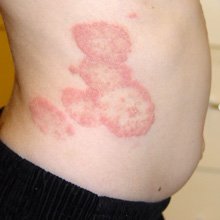Ringworm (tinea or dermatophytosis) is a kind of parasitic disease of the skin that really has nothing to do with worms. The contamination can happen pretty much anyplace on the body and has distinctive names relying upon which part of the body it influences. So, let us study Ringworm Causes, Symptoms, Treatment, and Prevention and more.

Ringworm causes
Ringworm is a shallow parasitic contamination that doesn’t cause illness beneath the surface of the skin. Ringworm of the body, particularly the storage compartment and appendages, is called tinea corporis. Contaminations on different regions of the body are called:
The (Athlete’s foot) Tinea pedis: on the bottoms of the feet
(Athlete’s foot) Tinea cruris: on the crotch, inward thighs, and hindquarters
The Tinea barbae: on the whiskers territory
Tinea manuum: on the palms of the hands
(Onychomycosis) Tinea unguium: on the fingernails and toenails
Indications and Stages of a Ringworm Infection:
skin rash that itches, ringworm causes
The particular indications of ringworm rely upon the area of the disease. They normally include:
1.Irritated skin
Red, textured or split skin
A ring-formed rash (from which ringworm gets its name)
Male pattern baldness in the influenced region (if the hair was available)
The indications have a tendency to show up in the vicinity of 4 and 14 days after the skin comes into contact with the parasites that reason ringworm.
Ringworm commonly begins as red or pink skin fixes (or recognizes) that might be either level or marginally raised. In this underlying stage, the injuries might be clammy, yet more frequently they’re dry, layered, and irritated.
After some time, the rash will increment in an estimate. Next, the focal point of the rash will begin to clear up, leaving a ring-molded contamination with a red, raised outskirt and a solid looking focus (in spite of the fact that the inside may stay flaky and red). On the off chance that you scratch the rash you may break the skin, which could prompt a bacterial disease.
What’s more, on the off chance that you promptly contact different territories of your body in the wake of scratching, you may likewise unintentionally spread the ringworm contamination. So treating whenever there’s any hint of disease is imperative.

Side effects of ringworm can be diversely relying upon the particular piece of the body that is influenced:
ringworm causes
On the feet (tinea pedis, or “competitor’s foot”): Skin may wind up swollen, red, and bothersome between the toes. The bottoms and rear areas of the feet may likewise be influenced. In serious cases, the ranking of the skin can happen.
In the crotch territory (tinea cruris, or “athlete tingle”): Itchy, textured red spots typically show up on the internal thighs.
The scalp (tinea capitis): Ringworm can resemble a bothersome, textured, kindled uncovered spot, and it can develop an estimate. Scalp diseases are more typical in kids than grown-ups.
In the whiskers (tinea barbae): Itchy red spots are noticeable on the cheeks, jaw, and upper neck. The spots may end up dried up and may cause hair that is influenced to drop out.
On fingernails and toenails (onychomycosis): In this, some of the nails of finger and toe becomes thick and weird and shady. Onychomycosis regularly happens in individuals who have competitor’s foot for a drawn-out period.
The American Academy of Family Physicians takes note of that diagnosing ringworm can be somewhat dubious, on the grounds that it regularly looks like different conditions.
Ringworm Causes and How Do You Get It?
ringworm causes
Ringworm isn’t caused by worms or parasites, but instead by growths known as dermatophytes. In this, the infected area turns out in a ring shape thus it is said ringworm. In this rashes are raised in that particular area.
If we talk about organisms which can spread or which are the main ringworm cause are in the Microsporum, Trichophyton, and much more. There are almost 40 different types of organisms that can cause ringworm, as indicated by the Centers for Disease Control and Prevention.
Tinea corporis is generally caused by a few unique animal types of Trichophyton fungi: T. Rubrum, M. Canis, or T. tonsurans.
Like different kinds of growths, dermatophytes flourish in warm, damp zones. In this infection, you can also get it from close contact with the surfaces that harbor the organisms.
An expected 10 to 20 percent of the total populace is influenced by contagious skin diseases, as indicated by a report distributed in 2014 by the Cochrane Database of Systematic Reviews. Ringworm Causes are all you need to know to stay away from it and you should always be aware of ringworm causes and its symptoms.
Is Ringworm Contagious and How Can I Prevent It?
ringworm causes
Ringworm is exceedingly infectious before side effects are even obvious. You can get ringworm by:
Having direct, skin-to-skin contact with influenced regions of a tainted individual’s body.
Playing with pets. With cats and young dogs in houses, are regular transporters, as per the National Institutes of Health (NIH). Touching other contaminated creatures, for example, guinea pigs or homestead creatures like sheep and cows can likewise prompt a disease. In some cases a creature’s contamination resembles a zone where the hide is sketchy or textured, however, the signs may not generally be noticeable to you.
When you come in direct contact with infected and polluted parasites, for example, dress, towels, seats, and toilets.
Having drawn out an introduction to the tainted soil, however, this is uncommon.
Will probably create ringworm in the event that you have poor cleanliness, enable your skin to remain wet for quite a while, (for example, from perspiring), have nail or skin wounds (open injuries — even minor ones), or take part in exercises in which you have close contact with different creatures or individuals.
Article Source: https://fattofitfarm.com/ringworm-causes-symptoms-treatment/